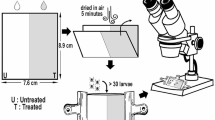Abstract
When they are mechanically disturbed, all instars of the tropical bont tickAmblyomma variegatum exude droplets of a liquid on the dorsal, lateral, and ventral cuticle. These spread out and quickly evaporate. In this study, the possible role of these secretions was investigated in relation to predators and pathogens. In laboratory bioassays, it was demonstrated that the secretions from engorged larvae, nymphs, and females have an antibiotic activity against the bacteria speciesBacillus thuringiensis andSerratia marcescens, combined with a repellent effect on a potential predator, the fire-antSolenopsis geminata.
Similar content being viewed by others
References
Barré, N., Mauléon, H., Garris, G.I. andKermarrec, A. 1991. Predators of the tickAmblyomma variegatum (Acari: Ixodidae) in Guadeloupe, French West Indies.Exp. Appl. Acarol. 12:163–170.
Diehl, P.A., Guerin, P., Vlimant, M., andSteullet, P. 1991. Biosynthesis, production site and emission rates of aggregation-attachment pheromone in males of twoAmblyomma ticks.J. Chem. Ecol. 17(5):833–847.
Dunn, P.E. 1986. Biochemical aspects of insect immunology.Annu. Rev. Entomol. 31:321–339.
Hackmann, R.H. 1982. Structure and function of tick cuticle.Annu. Rev. Entomol. 27:75–79.
Kimbrell, D.A. 1991. Insect antibacterial proteins: Not just for insects and against bacteria.BioAssays 13(12):657–663.
Lees, A.D. 1947. Transpiration and the structure of epicuticle in ticks.J. Exp. Biol. 23:379–410.
Mauléon, H., Barré, N., andPanoma, S. 1993. Pathogenicity of 17 isolates of entomophagous nematodes (Steinerematidae and Heterorhabditidae) for the ticksAmblyomma variegatum (Fabricius),Boophilus microplus (Canestrini), andBoophilus annulatus (Say).Exp. Appl. Acarol. 17(11):831–838.
Samish, M., andGlazer, I. 1991. Killing ticks with parasitic nematodes of insects.J. Invertebr. Pathol. 58:281–282.
Samish, M., andGlazer, I. 1992. Infectivity of entomopathogenic nematodes (Steinernematidae and Heterorhabditidae) to female ticks ofBoophilus annulatus (Arachnida: Ixododae).J. Med. Entomol. 29(4):614–618.
Uilenberg, G., Barré, N., Camus, E., Burridge, M.J., andGarris, G.I. 1984. Heartwater in the Caribbean.Prev. Vet. Med. 2:255–267.
Yoder, J.A., Pollack, R.J., Spielman, A., Sonenshine, D.E., andJohnston, D.E. 1993a. Secretion of squalene by ticks.J. Insect Physiol. 39(4):291–296.
Yoder, J.A., Pollack, R.J., andSpielman, A. 1993b. An ant-diversionary secretion of ticks: First demonstration of an acarine allomone.J. Insect Physiol. 39(5):429–435.
Zupko, K., Skan, D., andLensky, Y. 1993. Proteins of the honeybee (A. mellifera) body surface and exocrine gland secretions.J. Insect Physiol. 39(1):41–46.
Author information
Authors and Affiliations
Rights and permissions
About this article
Cite this article
Pavis, C., Mauleon, H., Barre, N. et al. Dermal gland secretions of tropical bont tick,Amblyomma variegatum (Acarina: Ixodidae): Biological activity on predators and pathogens. J Chem Ecol 20, 1495–1503 (1994). https://doi.org/10.1007/BF02059875
Received:
Accepted:
Issue Date:
DOI: https://doi.org/10.1007/BF02059875




